Fried Beef Empanadas: Tricks and Thermal Tips for Flaky Results
Can we agree that hand pies are an absolute culinary treasure? Whether the English pasty, the Amish fried pie, or the Latin American empanada, they’re all good. In fact, today we’re going to take a look at empanadas. To be more specific, we’re going to look at fried beef empanadas with an Argentinian-style filling. Yum!
In this post, we’ll look at the filling, the dough, folding and stuffing, and the best oil temperatures for frying these beauties. What we end up with is pure joy. Let’s get to it!
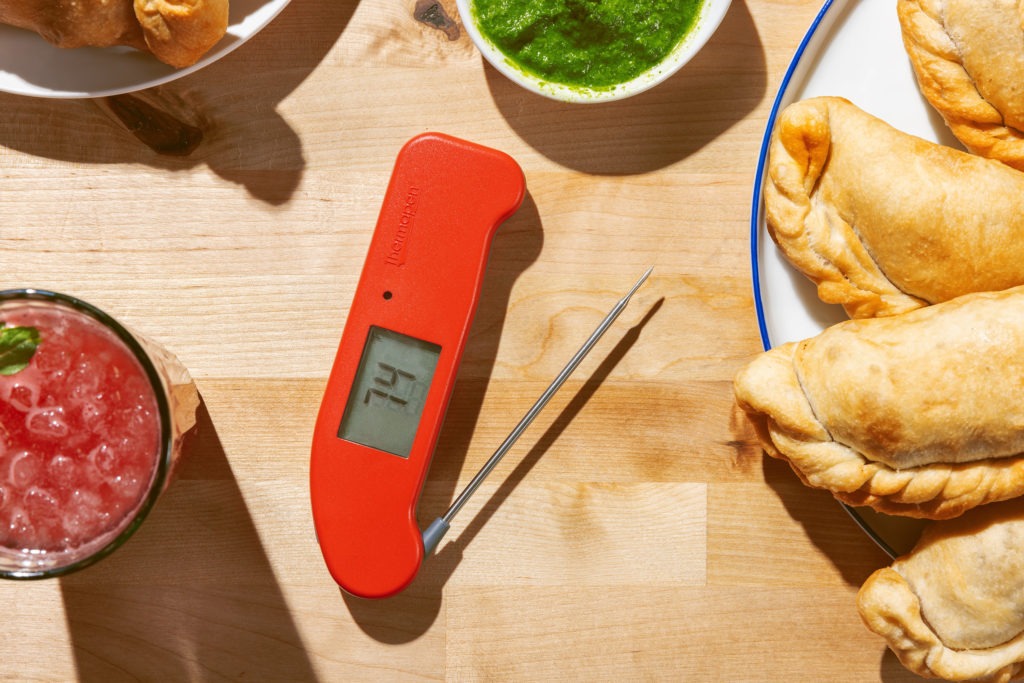
What makes a good empanada
Empanada fillings
Empanadas are wonderful for their versatility. By that, I don’t just mean that they are super packable, and can easily be taken on the road, but that the empanada itself can be good for any kind of filling you want to through at it. Yes to seasoned ground beef. Yes to shredded chicken. Yes to ham and cheese, yes to diced apples with cinnamon, yes to pork barbacoa, yes to all your heart’s culinary desires. Once you’ve mastered the dough and the filling process, you have the whole world in the palm of your hand.
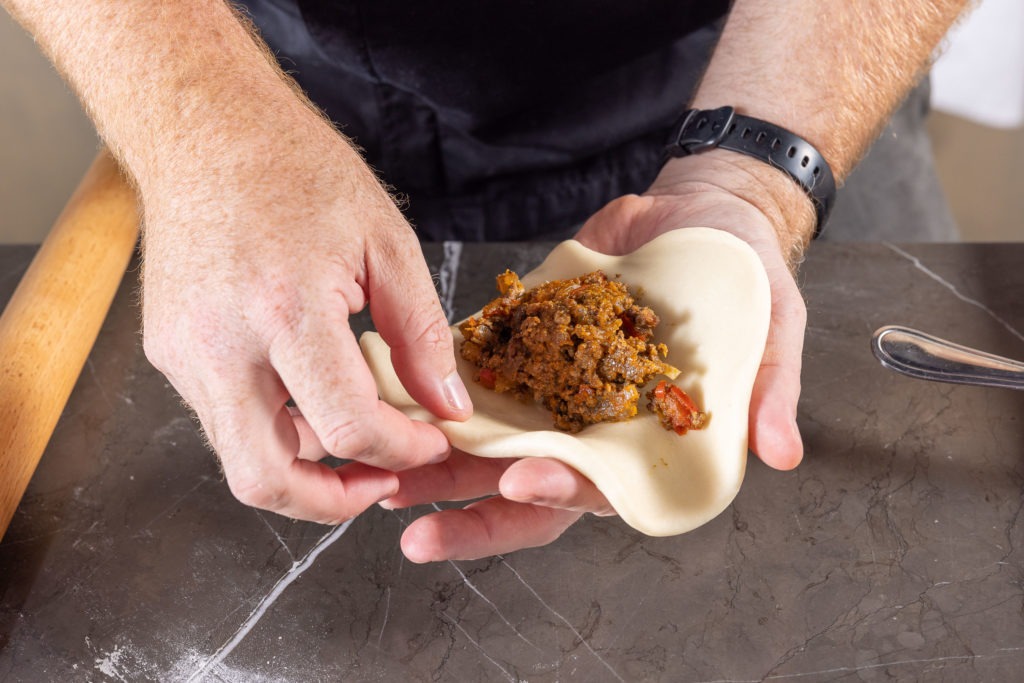
I love the Argentinian-style ground beef filling. It incorporates a plethora of spices as well as onion, red pepper, raisins, and—to crown the whole thing—a little bit of green olive. The spices complement the beef, the sweetness of the raisins balances the spices, and the sharp, sudden brine of the green olive keeps the raisin sweetness from overpowering. It’s a masterclass in balance, and it’s all shoved into a simple crust for portability. Fantastic. (We took inspiration from Gaby Melian, formerly of Bon Appetit, for the filling.)
Good empanada dough
But given your choice of fillings, what else makes an empanada good? The crust, of course. After all, the crust is the pan (Spanish for bread) in the empanada. You want a dough that is good enough to want to eat on its own. Chances are good that the last bite of your pastry will mostly be crust, you may as well make it enjoyable! Though there are many styles of empanada dough you can use, here we opt for a rich dough that stretches easily. (Big shoutout to Curious Cuisiniere, from whom we modified our dough recipe.)
Mixing, kneading, portioning, and rolling out the dough-discs can cause the dough’s gluten strands to tense up, get tight, and resist. To counter this tendency, we start with all-purpose flour, which has a lower protein (gluten) content. Then, we mix the dry ingredients with oil (butter in this case, though lard would also work well) to coat the flour granules with fat before we introduce the water and mix until it’s smooth-ish. This is, in essence, the biscuit method—and it pays off. The dough is easily extensible and pliable while not wanting to shrink back into a ball at the least provocation.
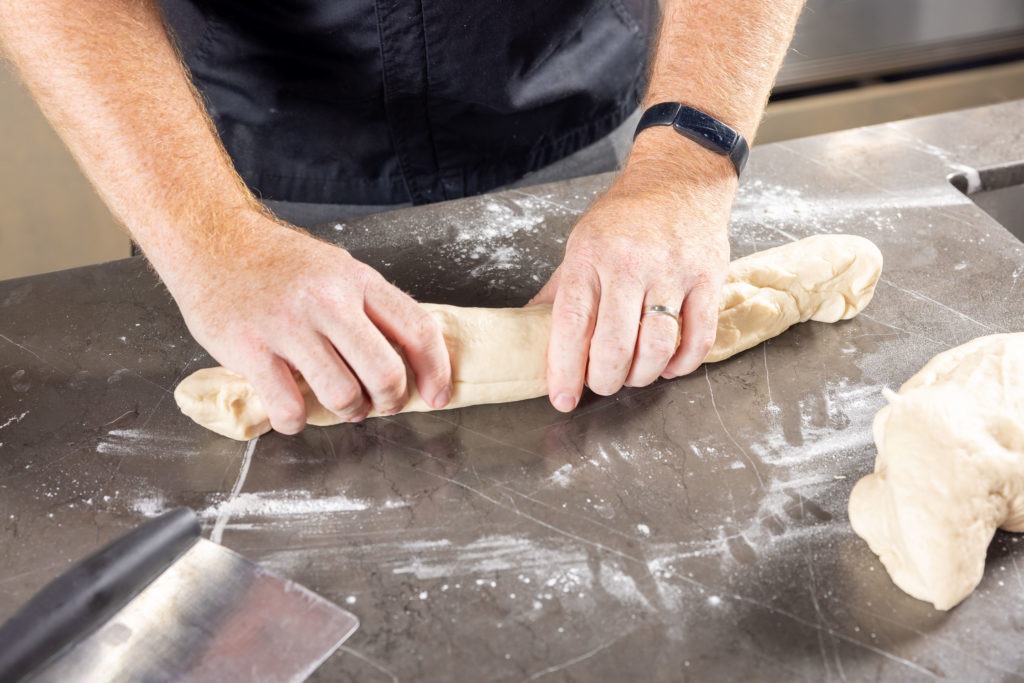
Filling and sealing empanadas
The best filling and the best dough won’t do you any good if your empanadas won’t stay closed when floating in fry oil, and won’t matter much if your dough is oil-logged and soggy after frying. To prevent these culinary disasters, you need to seal your empanadas well and fry them at the right temperature.
How to seal your empanadas
Sealing empanadas is the most difficult part of the cook, but it’s really not all that bad. There are a few things to look out for, though. For instance, it’s tempting to overstuff the dough, but go easy on the filling! The filling will look small on the dough, but it will end up being more than you think, and overstuffing causes filling blow-outs in the oil. Two to three tablespoons of filling will be plenty.
Also, you should try to get as much air out of the pocket as you can. Excess air will expand in the hot oil and make a large bubble that makes it hard to turn and cook the empanadas. You won’t be able to get rid of all the air, obviously, but just try to press the dough down close to your toppings to eleminate gaps.
Roll out your empanada dough into a disc about 6″ in diameter and place a small heap of filling in the center (not more than about 3 Tbsp). Fold half the disc over the filling. Press the dough together along the seam and pick up the empanada in your left hand. With your right hand, crimp the bottom corner of the dough in on itself, then make another fold that overlaps it. Continue, folding and crimping, all along the edge. Set the completed empanada aside and make the rest of them.
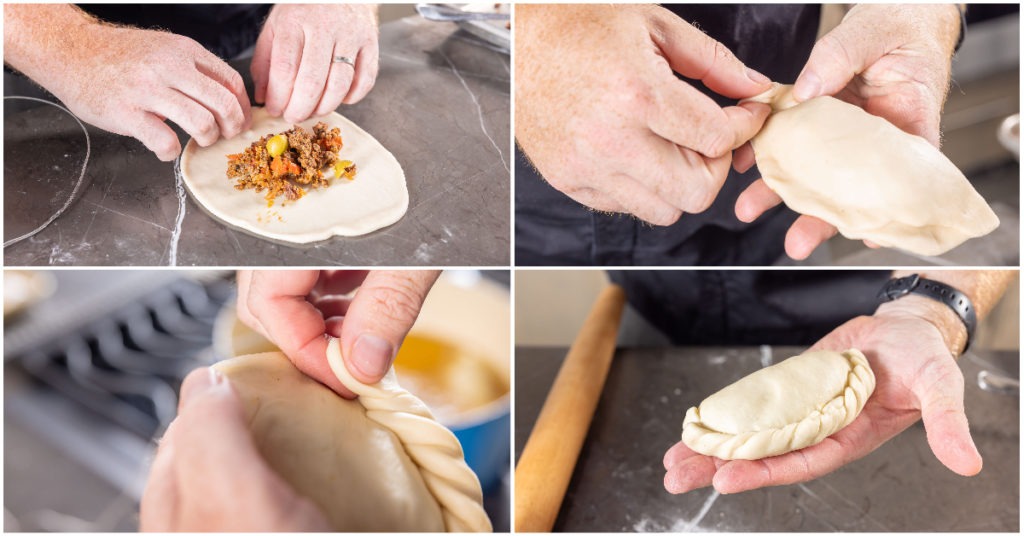
Frying temperature for empanadas
We’ve already established that the crust is the key to a good empanada, but the key to a good crust for a fried empanada is temperature control. Frying at 350°F (177°C) will result in an empanada that is crisp-flaky, and light, not oil-logged. Old recipes will tell you to pinch a piece of dough and drop it in the oil to see if it sizzles, but sizzling happens at a wide range of temperatures, not only at 350°F (177°C), so using a thermometer to gauge the temperature is super important.
If you have a ChefAlarm®, you’re well set—its high- and low-temp alarms are perfect for adjusting the heat to keep it in range. In fact, we consider ChefAlarm to be the best thermometer for deep frying! But if you don’t have one (yet) you can certainly use your Thermapen® ONE to monitor the oil temperature. Keep it close to hand and check the temperature often, adjusting your heat to keep it as close as you can to the target temp.
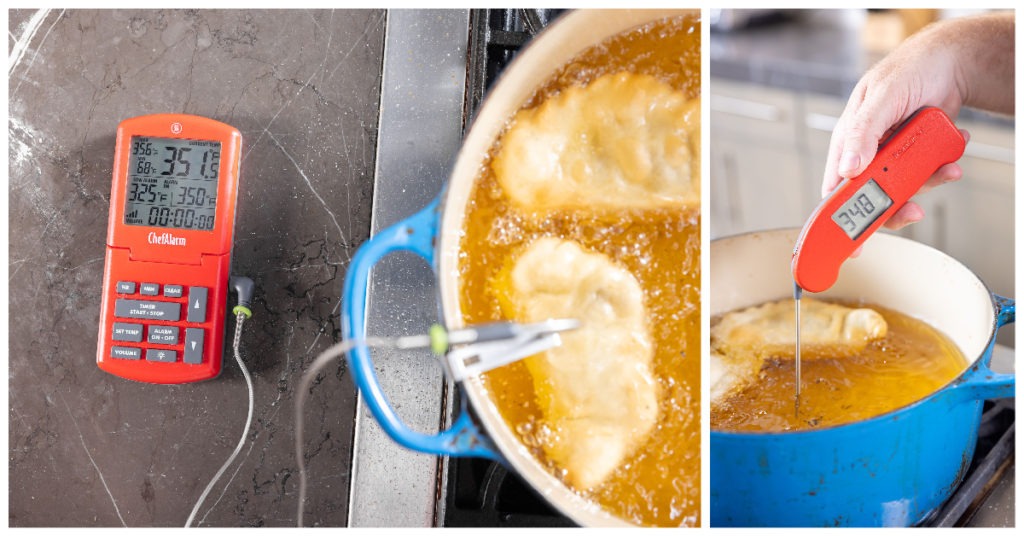
These empanadas are delicious. And once you get the sealing operation down, they’re really not hard to make. Double the batch—triple it!— and freeze some for later, or just make enough for your family tonight. They’ll love it, and so will you. This dough recipe works well for sweet or savory empanadas, so you can mix up the recipe however you see fit. Just be sure to monitor your fry temps so you don’t burn your beauties or sog them with oil. Give them a try this weekend, you’ll be glad you did!

Fried Beef Empanadas: Tricks and Thermal Tips for Flaky Results
Description
Fried beef empanadas, based on recipes from Bon Appetit and Curious Cuisiniere. Makes 18 empanadas
Ingredients
For the filling
- 1½ Tbsp extra-virgin olive oil, divided
- 1 lb ground beef (20% fat)
- 1 medium onion, chopped
- 1 small to medium red bell pepper, seeded, chopped
- 2 tsp Kosher salt
- 1/4 tsp freshly ground pepper
- 1½ Tbsp ground cumin
- 1Tbsp sweet paprika
- 1½ tsp dried oregano
- 1/8 tsp cayenne pepper
- 3/4 C chicken stock or broth
- 1 tsp sugar
- 1/4 C raisins
- 1/4 C pitted green olives, cut in half lengthwise
For the dough
- 8 C (1kg) all-purpose flour
- 1 C butter (or lard), softened
- ¾ C granulated sugar
- 1 tsp salt
- 1 ¾ C water
You will also need a quart or two of high-smoke point oil, such as peanut or corn oil.
Instructions
First, make the filling so that it can cool while you make the dough.
- In a large saute pan, heat half the oil over medium-high heat.
- Add the ground beef and cook, breaking it up into small pieces. Cook until the beef is almost, but not quite, done.
- Remove the beef to a bowl, leaving as much fat in the pan as possible. Set the beef aside and put the pan back on the heat.
- Add the chopped onion and peppers as well as the rest of the oil to the pan and saute until translucent.
- Add the spices and herbs with the salt and pepper to the pan and cook until fragrant.
- Pour in the chicken stock and add the reserved beef and the raisins. Simmer the mixture over medium-low heat until almost all of the liquid has cooked out.
- Pour the mixture into a shallow bowl or a pan and cool it on the counter and then in the refrigerator until chilled. (Spreading it out on a sheet tray will speed the cooling quite a bit. Thermal thinking!)
Prepare the dough
- Combine the dry ingredients for the dough in the bowl of a stand mixer. Stir to homogenize.
- Add the softened butter and mix to combine. The mixture should resemble a coarse meal.
- Add the water and knead with a dough hook until the dough is soft, pliable, and fairly smooth.
- Turn the dough out onto your countertop and portion it into 18 equal-sized pieces.
- Roll each piece on the countertop to form a ball. Put them all on a sheet tray and set them aside to rest for 20 minutes. Cover them with a cloth to prevent drying out.
Fill and fry the empanadas
- Start heating 3″ of oil in a deep Dutch oven or pot. If using ChefAlarm to track the temperature, use the included pot clip to attach the probe to the pot and set the high-temp alarm for 350°F (177°C) and the low-temp alarm for 325°F (163°C). If using Thermapen ONE, check the temperature every minute or so as you prepare the empanadas.
- Squash a dough ball into a flattish disc and roll it out into a 6″ circle. It does not need to be super thin! Don’t roll it as thin as you can, just go for 6″.
- Add 2–3 Tbsp filling to the center of the disc as well as two cut halves of a green olive. (You thought I’d forgotten the green olives, didn’t you?)
- Fold the bottom half of the dough over the filling to meet the top edge.
- Press the edges together, trying to expel as much excess air in the pocket as possible.
- Fold one corner of the crescent in over the rim, making a sort of little triangle on the border. Press that corner tightly. Now fold the point of that triangle in over the edge, etc. etc. Press each fold firmly as you go.
- Repeat for all the empanadas.
- When the oil comes to temperature, gently lower 2–3 empanadas into the oil and cook, turning occasionally with tongs, until they are golden brown and lovely all over.
- Remove the empanadas to a paper-towel-lined baking sheet to cool and drain. (Also, hold each empanada above the oil for a few moments to allow excess oil to run off and out of the empanada before moving them to the baking sheet.)
- Make sure that the oil temperature has returned to 350°F (177°C) before adding more food to cook, then continue cooking the empanadas in batches until they are all cooked.
- Serve the empanadas with something cold to drink and sit back to enjoy your empanadas, your life, and the compliments that are about to start rolling in!
Notes
I made a quick, improvised chimichurri to serve with our empanadas. It’s not super authentic, but it is super tasty. Roughly chop 1 bunch of cilantro, 1 bunch of flatleaf parsley, 1 serrano pepper, and 1 clove of garlic. Put them all in the jar of a blender, and add 1/4 C olive oil and 1/2 C white vinegar. Season with a heavy pinch of salt. Whiz until smooth, check for seasoning, and set aside for use. It’s very good, and everyone here wanted me to include it in this recipe, so here it is!
Shop now for products used in this post:


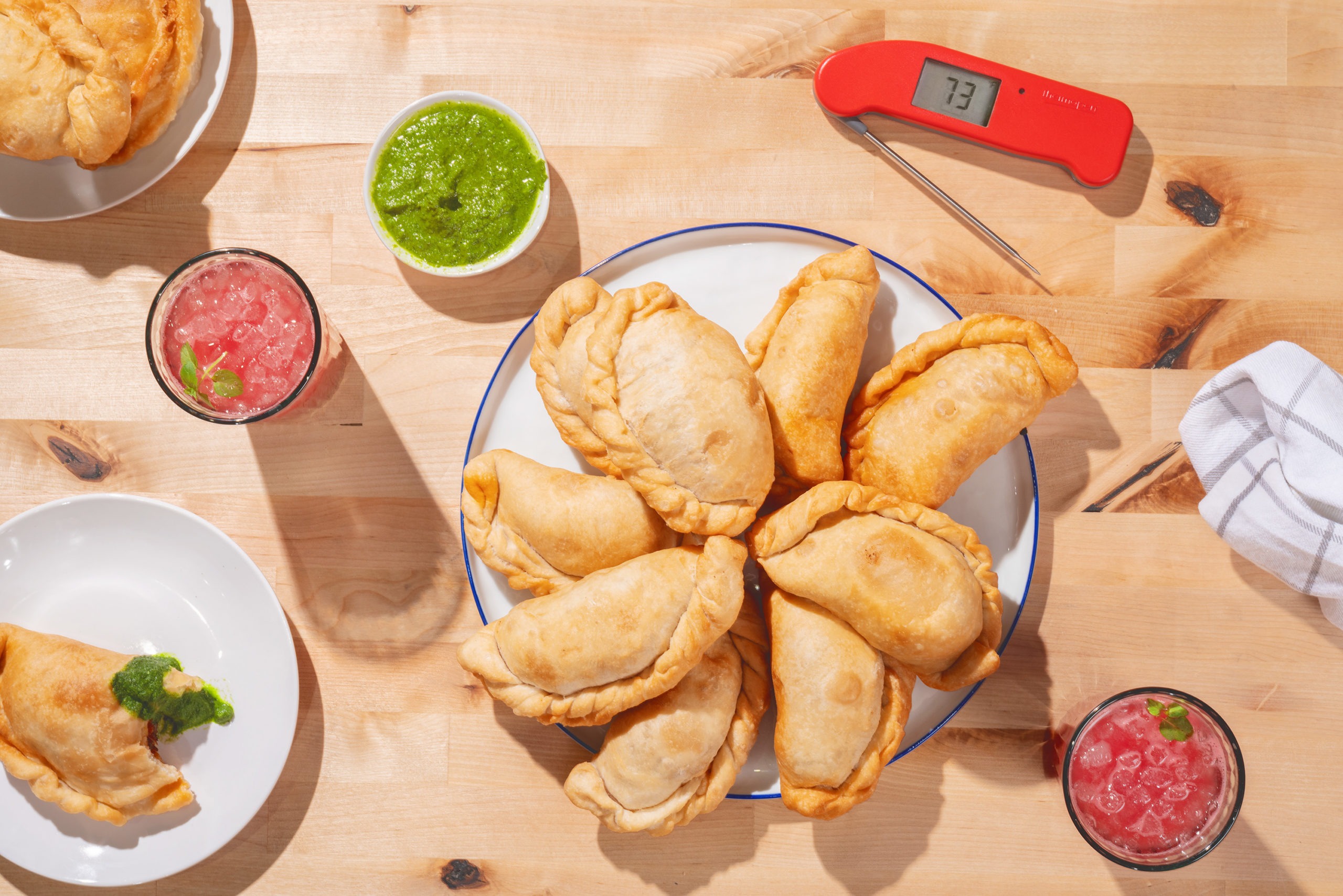
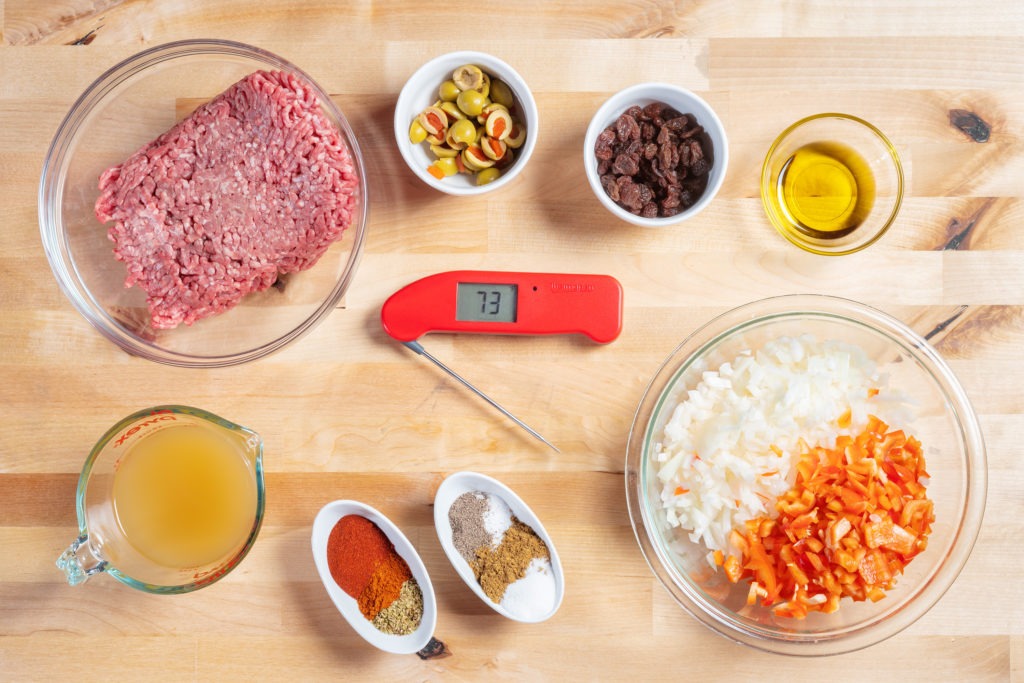
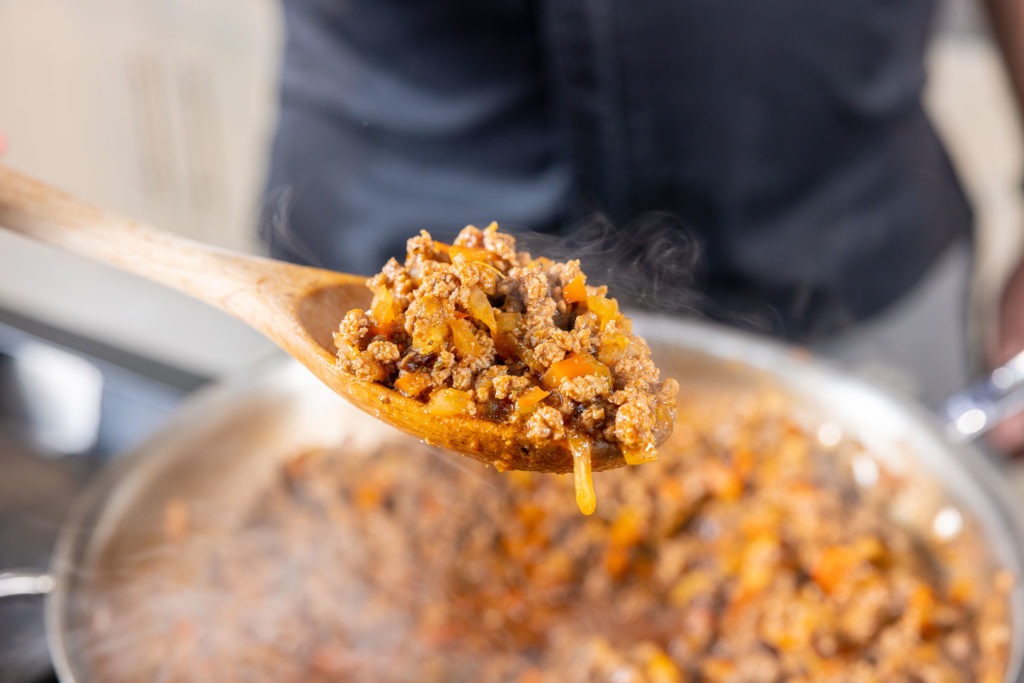
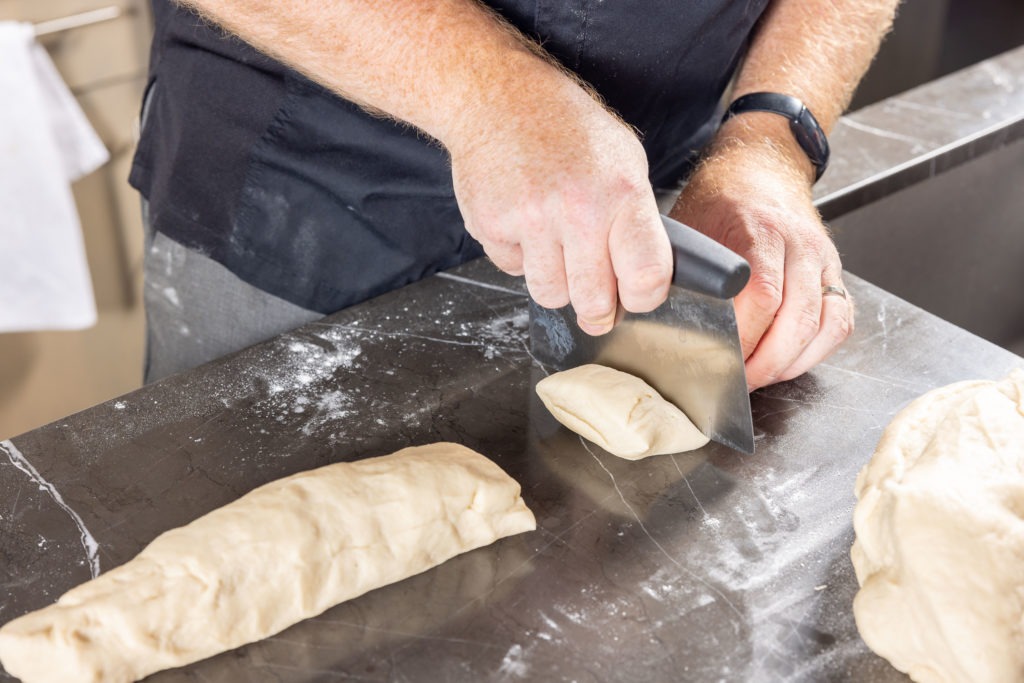
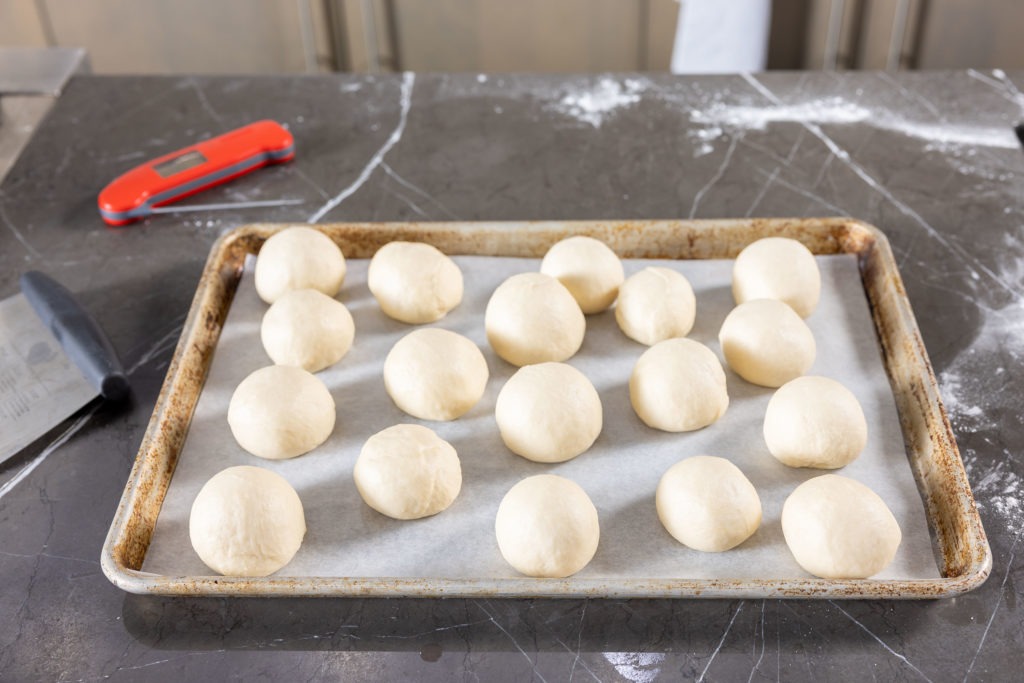
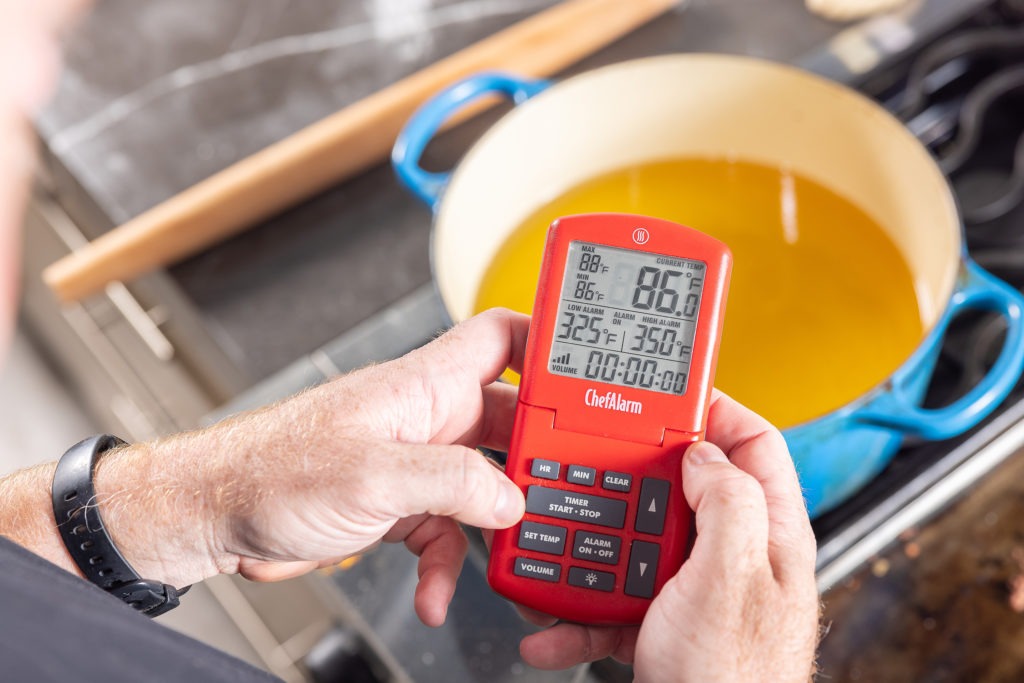
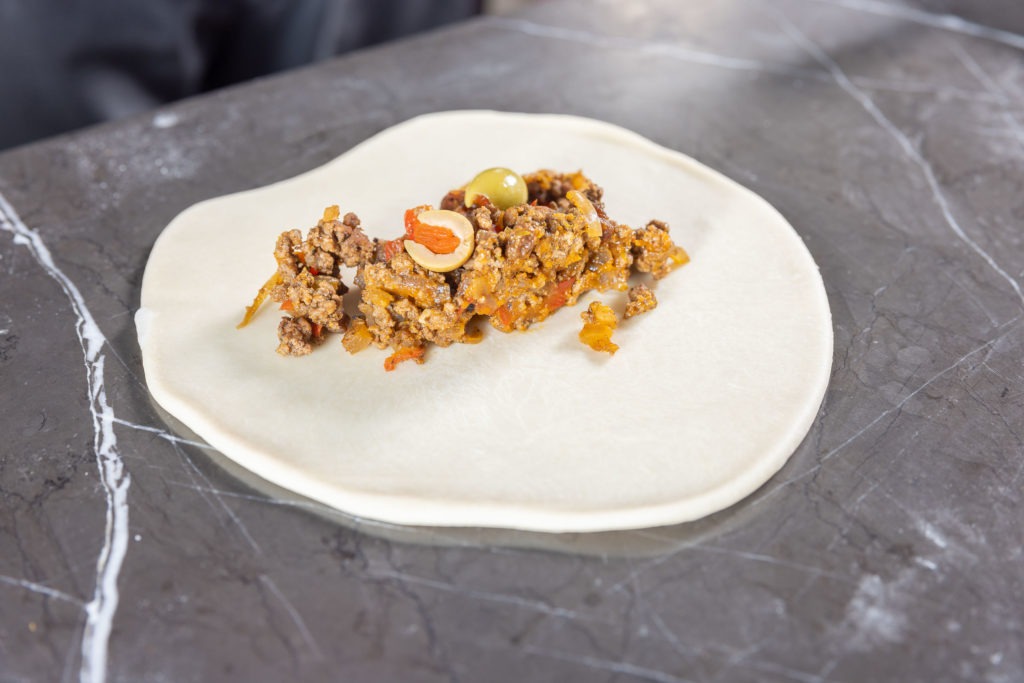
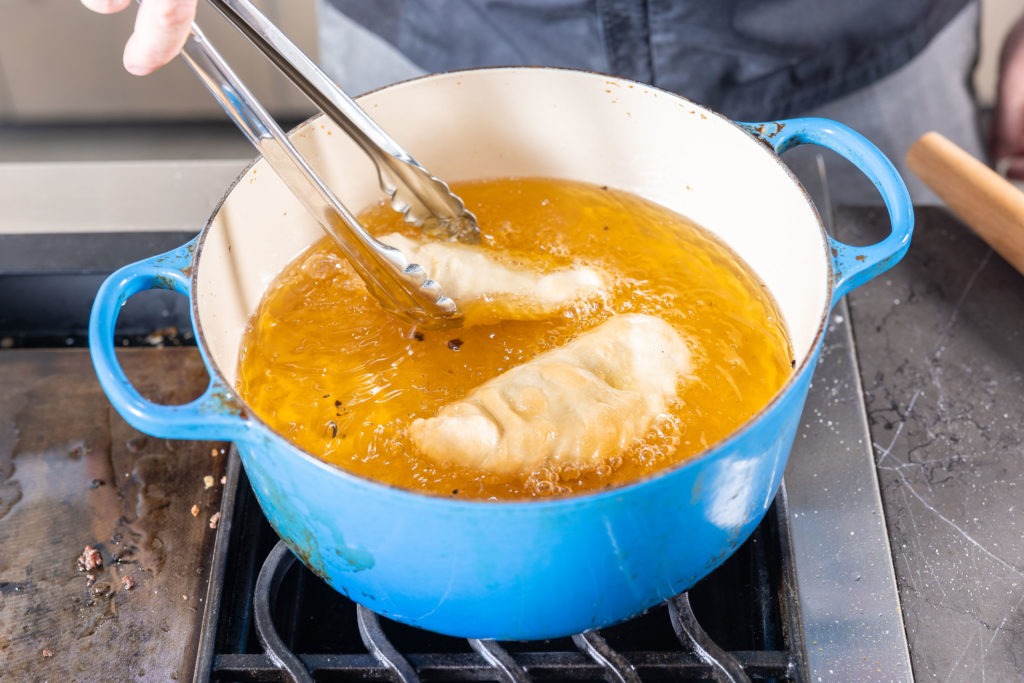
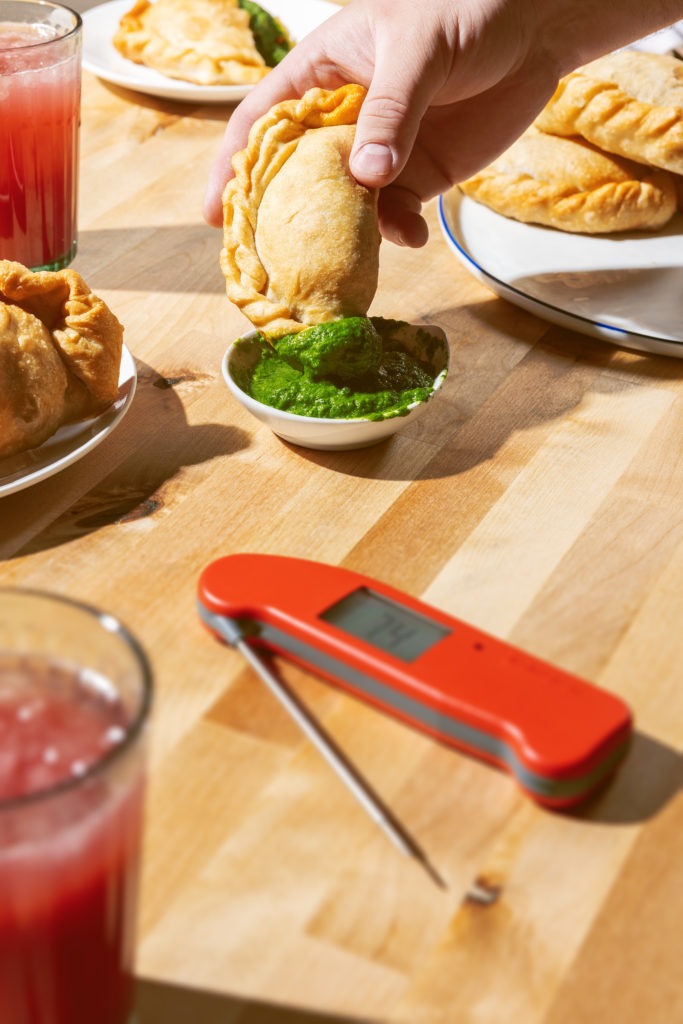


My wife is from Argentina, and empanadas are something I have become an expert at them over the past 20 years we’ve been married. As a small event caterer, I’m used to making 3-6 dozen empanadas — usually equal numbers of beef and chicken. To make your empanadas just a bit more “authentic”, some hard boiled egg needs to be added. Some folks slice them and add a slice to each empanada; we prefer to coarsely chop the whole egg and mix into the filling (in your recipe of 1# of meat, I would add 2-3 eggs. I also rinse my ground beef in a sieve with hot water to remove all fat, and you don’t want excessive moisture in the filling because that, too, will boil out of the dough and make a mess of the oil.
Your dough recipe appears to be spot on! We usually use store-bought dough, but the quality can be poor if they have not been kept frozen properly. I’ll give your recipe a shot the next time we’re in the mood to make empanadas.
The method my wife’s aunt taught me for filling the dough is to loosely cup the “tapita” (dough disk) in one hand and pinch the bottom end to begin the seal. Then you can spoon in the 2-3 tablespoons of filling without the excess air and easily complete the seal and roll the edge. It helps to moisten the circumference of the tapita with a little water to assure a good seal — I just dip two fingers into a bowl of water and quickly trace about 1/4″ along the entire outer edge. I can easily make 4-5 dozen in an hour, and can fry 12-15 at a time in a large braising pan.
Finally, your chimichurri is pretty close, but it should not be a paste as appears to be in your photo . . . it should be easily spreadable with a bit more liquid than solids. As often as I make chimichurri, I definitely think the recipe needs more EVOO and more garlic — it also seems a little too heavy on the acid-to-oil ratio at 2:1. I make large batches and mine are much closer to 1:1. The acid should not be the dominant flavor like that.
I’ll typically buy equal amounts of cilantro and Italian parsley by weight, then remove most of the stems. For one bunch each as in your recipe, the garlic needs to be 3-4 cloves. For convenience, I combine the greens well in a bowl and then pulse them in a food processor with the garlic until minced. Then I mix by hand with the oil in a separate bowl and add the acid to taste. We much prefer lemon juice to vinegar for the aroma along with the acidity (we also have a lemon tree which makes it convenient), and depending on one’s taste, it can take several cups of EVOO and the juice of several large lemons for a batch consisting of 3-4 bunches of parsley and 4-6 bunches of cilantro 10-12 large cloves of garlic. We have always added crushed red pepper instead of fresh chiles . . . just enough to give it a “spark.”
I would encourage your readers to make larger batches . . . left over chimichurri can be stored in a closed container in the refrigerator for weeks. The oil will likely solidify at the low temperature, but liquifies quickly at room temperature or in a few seconds in the microwave. It’s a very versatile condiment, and we love it slathered on steaks and slices of crusty (but not toasted) baguettes. We’ve never had it on empanadas — which are normally enjoyed as presented out of the fryer or oven (and I don’t ever recall being served chimichurri with empanadas in an Argentinean restaurant). We mix it into tuna for sandwiches, into scrambled eggs with sausage bits (or chorizo), onions, and bell peppers, and spread it on bread for ham or turkey sandwiches instead of mayonnaise. We’ll also use it for marinating/pounding chicken breasts for milanesas — another Argentinean delicacy.
Considering empanadas in most restaurants are running $3 each or more, learning to make them at home is a real joy! You can make several dozen for well under $20-$25, even with today’s $3+ per pound ground beef. Try making some with pulled pork or shredded chicken, or ham and mozzarella cheese. Blanched, seasoned, and freshly chopped spinach with mozzarella is also a very typical filling.
Max,
Thank you so much for your comment! I’ll have to make a batch of chimichurri according to your instructions, as it sound delicious. Also, I absolutely love the idea of chopped boiled egg in the filling. Yum!
Hi Martin,
Thank you for all your tips for successful batches of Empanadas!
Just ONE question.
What oil do you fry them in and for how long?
Okay one and a half questions.
I like peanut oil or corn oil, but I could go so far as good freshly rendered pork lard (see your local Latin market). Something with a high smoke point and not a lot of flavor is great. It takes only a few minutes to cook each one.
I made this a night ago and it was delicious! I agree the the acid to oil ratio would be better at 1:1 for the chimichurri but it was still very good! I did use a Jalepeno pepper vs the noted Serrano as it was all I had. We liked the kick in the chimichurri! Otherwise followed the recipe exactly…dough came out perfect and very easy to make and work with for the empanadas. We had the leftovers the next night, pretty much perfect warmed in the oven at 325F for 15 min!
Fantastic! I’m so glad you liked it.